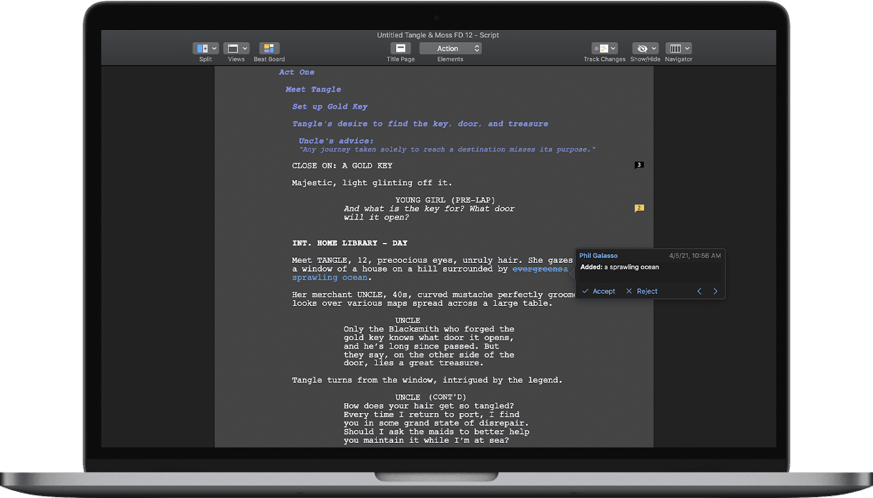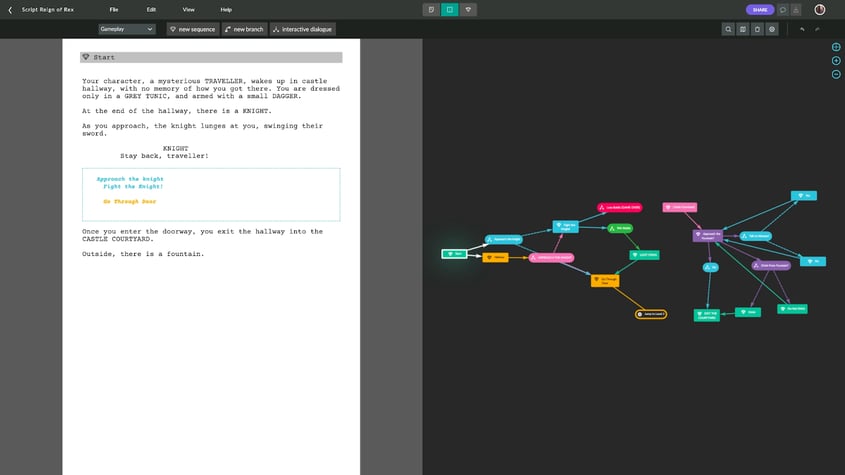When game writers need a tool to craft a narrative, Final Draft may be one of the first solutions they find. While Final Draft is widely recognized as the “O.G.” industry standard for traditional script writing. If linear content is what you’re after, Final Draft or newer solutions like Celtx may work just fine.
However, if you need something geared towards interactive media like video games, a purpose-built narrative design platform like Gem—with its script-style writing tool—will offer many new advantages.
In this blog post, we will compare Final Draft and Gem, highlighting the strengths, weaknesses, and what sets them apart for interactive storytelling.
About Final Draft

Image source: finaldraft.com
Final Draft has earned its reputation as the go-to software for traditional screenwriting because of its formatting features that help scripts meet industry standards. It’s been around since 1990, so it has the high ground of being legacy software in the industry.
Final Draft Features:
- Easy Script Formatting: Allows users to use tab and enter to quickly format a script
- Predictive Typing: Predict and insert common phrases, character names, and more.
- Templates: Quickly start new scripts for sitcoms, full-length films, theater, etc.
- Outline Editor: A linear representation of a script
- Beat Board: Add virtual index cards with text and images
- Comments: Allows users to flag and comment on a script.
- Line Versions: Store multiple versions of a line during collaboration
- Real-time Editing: See changes added by collaborators as they happen
Common Complaints of Final Draft:
Users often express frustration with the limited collaboration features, leaving many users who are accustomed to modern collaboration platforms wanting more. Final Draft is available as a desktop program and as a mobile app, but it is not available online. But perhaps one of the more concerning things is the lack of innovation and updates from Final Draft in an ever-evolving industry.
About Gem

Gem is an online, cloud-native narrative design platform with a unique focus on interactive narrative design and game development. Its features include traditional screenplay formatting but also offers much more to cater to the needs of game writers.
With AAA games having anywhere from 150k-350k lines of dialogue, the complexity of game narratives demands a specialized solution like Gem to streamline the process and ensure efficient production.
Gem was created to address the challenges faced by narrative teams during game development. Games, are highly iterative and require tools to handle changes in real time, especially in the voiceover (VO), Cinematic, and localization (LOC) pipelines. Without a narrative management solution like Gem, tracking and managing these changes is very difficult.
Gem Features:
- Screenplay-Style Script Editor: Gem has a screenplay-style script editor, enabling the formatting of dialogue, gameplay, character actions, and more.
- Visualizing Narrative Elements: Gem allows users to visualize every key narrative element through nodes, facilitating better orientation for designers and writers.
- Custom Conditions and Variables: With Gem, users can create interactive experiences that respond to players' choices using custom conditions and variables.
- Collaboration Made Easy: Beyond script comments and tagging users, Gem users can see where their collaborators are working within a narrative branch. Their cursor movement and edits can be seen in real-time to keep teams in sync and to prevent interfering with ongoing work.
- Heatmap and Prototyping: The built-in heatmap helps observe and review narrative structure logic paths, while rapid prototyping features speed up the process of creating a narrative framework.
- Asset Organization and Localization: Gem's detailed Catalog feature keeps assets organized, and its flexible metadata ontology supports localization efforts.
- Bi-Directional API Integration: Gem can integrate narrative content with other game development tools to improve the development pipeline.
Common Complaints about Gem
Users who are used to working within a standard writing environment experience a learning curve when it comes to using the wider feature set of Gem. Instead of offering a pure writing approach, Gem uses a node-based approach. This requires users to remove their hands from the keyboard to use their mouse. Gem also introduces logic into the writing process. This can be challenging for new users but will offer massive advantages to the wider team down the pipeline.

Final Thoughts on Gem Vs. Final Draft
Both Final Draft and Gem have their strengths, catering to different types of storytelling. Final Draft excels in screenplay formatting for traditional linear media, while Gem takes the lead in writing interactive content that must accommodate both creative and technical teams throughout the game development pipeline.
Finally, we must consider the fact that these two writing tools are different by nature. Final Draft is purpose-built for things like feature films, which may have a script of 120 pages. Gem, however, is purpose-built for games, which can have scripts of 1000-6000 pages! Only Gem has the features required to manage the writing load at such scale and complexity.